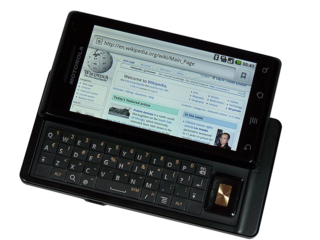
The Motorola Droid is an Internet and multimedia-enabled smartphone designed by Motorola, which runs Google's Android operating system. The Droid had been publicized under the codenames Sholes and Tao and the model number A855. In Latin America and Europe, the model number is A853 (Milestone), and in Mexico, the model number is A854 (Motoroi). Due to the ambiguity with newer phones with similar names, it is also commonly known as the DROID 1. The brand name Droid is a trademark of Lucasfilm licensed to Verizon Wireless.
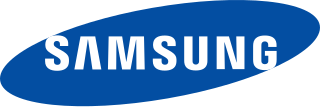
The Samsung Wave is a smartphone developed and produced by Samsung Electronics. It is the first smartphone to run the Bada operating system developed by Samsung Electronics, which was commercially released on May 24, 2010. The Wave is a touchscreen phone powered by Samsung's "Hummingbird" CPU (S5PC110), which includes 1 GHz ARM Cortex-A8 CPU and a built-in PowerVR SGX 540 graphics engine. It also has a "Super AMOLED" screen and 720p high-definition video capture capabilities. Due to shortage of Super AMOLED screens, Samsung released a successor to the device called Wave II and ceased production of the original S8500 model.

The Samsung Galaxy S was a touchscreen-enabled, slate-format Android smartphone designed, developed, and marketed by Samsung Electronics; it is the first smartphone of the Samsung Galaxy S series. It is the first device of the third Android smartphone series produced by Samsung. It was announced to the press in March 2010 and released for sale in June 2010. Due to shortage of Super AMOLED displays, Samsung released a successor to the device called S scLCD or SL and ceased production of the original I9000 model.
The Samsung i8520 is a projector-enabled smartphone produced by Samsung. Its main feature is a built-in DLP WVGA projector that is able to project images at up to 50 inches (1,300 mm) in size at 15 lumens. The i8520 also contains an 8-megapixel camera, that can be used along with the projector to allow the user to project directly what is in front of the camera. The camera is also able to record HD video at a resolution of 720p at 30 frame/s. The phone also offers local Wi-Fi connectivity, e-mail, and web browsing, as well as containing a built-in GPS receiver. It was released initially in Singapore on 17 July 2010 with the carrier StarHub.
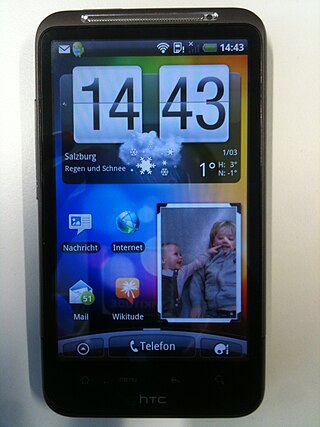
The HTC Desire HD is an Android smartphone by HTC Corporation. It was unveiled at a press event in London hosted by HTC on September 15, 2010, and was made available for sale in October in Europe and in January 2011 in Canada. The Desire was HTC's fourth flagship Android device until the release of their new line of flagship model, the HTC Sensation.

The Nexus S 4G is a smartphone co-developed by Google and Samsung and manufactured by Samsung Electronics for release in 2010. It was the first smartphone to use the Android 2.3 "Gingerbread" operating system, and the first Android device to support Near Field Communication (NFC) in both hardware and software.
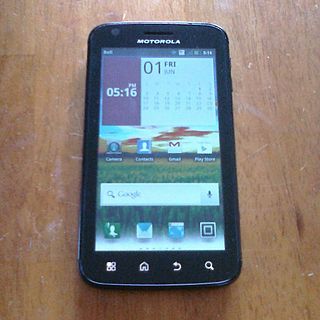
The Motorola Atrix 4G is an Android-based smartphone by Motorola, introduced in CES 2011 on January 5, 2011. It was made available in the first quarter of 2011. It was introduced along with three other products, Motorola Xoom, Motorola Droid Bionic, and Motorola Cliq 2. It uses an NVIDIA Tegra 2 dual core processor. It is the first phone to use a quarter-HD PenTile display with 24-bit graphics. The Motorola Atrix 4G is carried by the following wireless providers: AT&T Wireless US, Orange UK, Bell Canada CAN, Telstra AU. AT&T released Atrix on March 6.

The Samsung Infuse 4G it was an Android smartphone that was released by Samsung in May 2011. It has a 1.2 GHz Hummingbird processor with 8–16 GB internal Flash memory, a 4.5 inch 480×800 pixel Super AMOLED Plus capacitive touchscreen display, an 8-megapixel camera and a 1.3-megapixel front-facing camera.
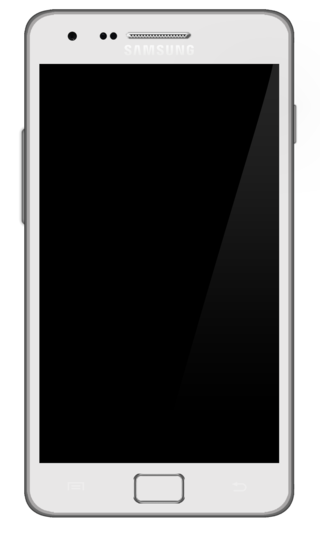
The Samsung Galaxy S II is a touchscreen-enabled, slate-format Android smartphone designed, developed, and marketed by Samsung Electronics, as the second smartphone of the Samsung Galaxy S series. It has additional software features, expanded hardware, and a redesigned physique compared to its predecessor, the Samsung Galaxy S. The S II was launched with Android 2.3.4 "Gingerbread", with updates to Android 4.1.2 "Jelly Bean".

The HTC Sensation is a smartphone designed and manufactured by HTC Corporation that runs the Android 2.3 Gingerbread software stock. Officially announced by HTC on April 12, 2011, the HTC Sensation was launched by Vodafone in key European markets including the United Kingdom on May 19, 2011 and by T-Mobile in the United States on June 12, 2011. It was HTC's fifth flagship Android phone and the first HTC phone to support the HTC Sense 3.0 user interface. At the time of its release, the Sensation XE was the world's fastest Android phone.
The Samsung Galaxy R (Royal) (GT-I9103) is an Android smartphone that was announced by Samsung on August 10, 2011 as a variant to the Samsung Galaxy S II.
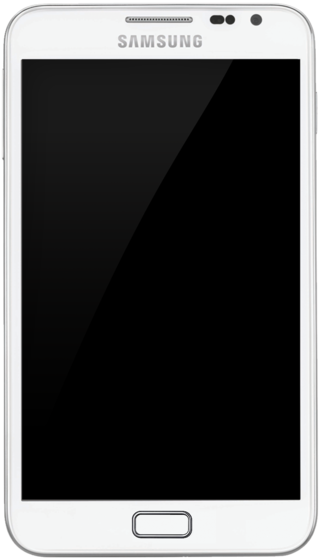
The Samsung Galaxy Note was an Android smartphone produced by Samsung Electronics. Unveiled at IFA Berlin 2011, it was first released in Germany in late October 2011, with other countries following afterwards. The Galaxy Note was distinguished by its unusually large form factor—later referred to using the term "phablet"—which straddled the size of the average smartphone at the time, and that of a small tablet: it features a 5.3-inch display, and is bundled with a stylus branded as the "S Pen", which can be used to navigate the device's user interface, and write or draw in supported apps.

Samsung Galaxy Y (GT-S5360) is an Android-based smartphone by Samsung, announced in August 2011. Its main features are 3G connection with speeds up to 7.2 Mbit/s and Wi-Fi.

The Sony Xperia S is an Android smartphone from Sony launched at the 2012 Consumer Electronics Show. It is the first Sony-only branded smartphone after Sony acquired Ericsson's stake in Sony Ericsson in January 2012. The Xperia S has a 4.3 in (110 mm) touch-screen with the mobile BRAVIA engine which optimizes the picture, a 1.5 GHz dual core processor, a 12.0-megapixel rear camera, HDMI-out, 1 GB of RAM, and 32 GB of internal storage.

The Samsung Galaxy Note II is an Android phablet smartphone. Unveiled on August 29, 2012 and released in October 2012, the Galaxy Note II is a successor to the original Galaxy Note, incorporating improved stylus functionality, a larger 5.5-inch (140 mm) screen, and an updated hardware and casing design based on that of the Galaxy S III.

The Samsung Galaxy S4 is an Android smartphone produced by Samsung Electronics as the fourth smartphone of the Samsung Galaxy S series and was first shown publicly on March 14, 2013, at Samsung Mobile Unpacked in New York City. It is the successor to the Galaxy S III, which maintains a similar design, but with upgraded hardware, more sensors, and an increased focus on software features that take advantage of its hardware capabilities—such as the ability to detect when a finger is hovered over the screen, and expanded eye tracking functionality, it was released the previous year. A hardware variant of the S4 became the first smartphone to support the emerging LTE Advanced mobile network standard. The T-Mobile version of the Galaxy S4, named the model (SGH-M919), was released the same month. The phone's successor, the Samsung Galaxy S5, was released the next year.
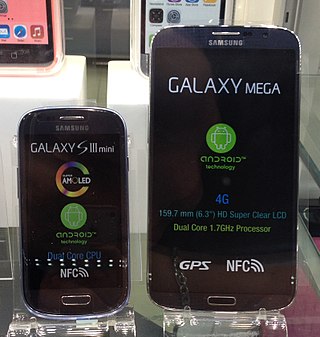
The Samsung Galaxy Mega is an Android-based phablet that was manufactured and released by Samsung. It was announced on April 11, 2013. The original model featured a 6.3 in (160 mm) screen, though a revised version was released with a 5.8 in (150 mm) screen. It has a 1,280×720 screen, a dual-core 1.7 GHz processor and an 8-megapixel camera. The phone runs Android 4.2.2 "Jelly Bean" software, and internal storage is 8 or 16 GB.

The Samsung Galaxy S4 Mini is an Android smartphone developed by the Korean manufacturer Samsung Electronics. Announced on May 31, 2013 and released in July 2013, the S4 Mini is a mid-range model of its flagship Galaxy S4 smartphone and a successor to the Galaxy S III Mini. It has a similar hardware design and software features to its high-end counterpart.
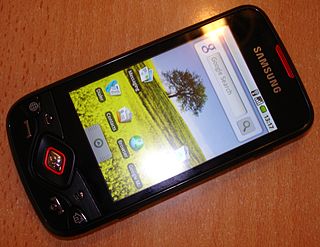
The Samsung Galaxy Spica, also known as Samsung Spica, Samsung GT-I5700, Samsung Galaxy Lite and Samsung Galaxy Portal, is a smartphone manufactured by Samsung that uses the open source Android operating system. The phone is positioned below the Samsung Galaxy (original). Even though some of its features like the camera resolution, storage and data connection speeds are lower than the i7500 its processor's clock speed is much higher at 800 MHz. It is succeeded by the Samsung Galaxy 3.
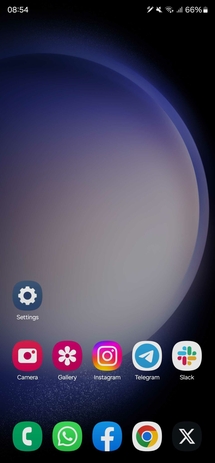
One UI is a user interface developed by Samsung Electronics for its Android devices running Android 9 "Pie" and later. Succeeding Samsung Experience and TouchWiz, it is designed to make using larger smartphones easier and be more visually appealing. To provide more clarity, some elements of the UI are tweaked to match colors that are based on the color of the user's phone. It was announced at Samsung's developer conference in 2018, and was unveiled in Galaxy Unpacked in February 2019 alongside the Galaxy S10 series, Galaxy Buds and the Galaxy Fold.























